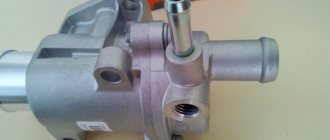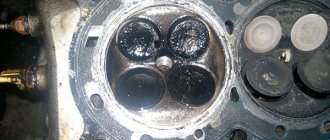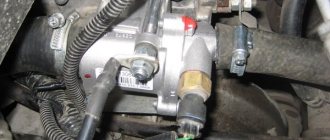A thermostat is a device that allows the engine to maintain a normal temperature. It is this device that allows you to quickly warm up the engine, as well as the interior of the car, even in the most severe frosts, and in the heat, prevent overheating of the internal combustion engine. It also provides the opportunity to reduce toxic emissions and effectively use fuel consumption.
The thermostat on the Priora is directly involved with antifreeze - coolant. Initially, when the engine has just started, antifreeze is used only in the OD jacket, as well as in the stove. But when it warms up to operating temperature, the liquid enters the radiator, which, together with the fan, allows the engine to maintain a normal temperature and not overheat at the right time.
How to replace a thermostat on a Priora
In order for the Lada Priora 16 valves, and any other car model, to work properly and not let the driver down on the road, the car owner must monitor the technical serviceability of the car and promptly repair any breakdowns. If during the next check an antifreeze leak is detected, then you need to first check the thermostat, which will most likely have to be removed and replaced. Replacing a thermostat on a Priora is not a difficult task, so every car owner can cope with such a task, if, of course, this process is carried out according to the instructions provided by professionals in their field.
Where is the thermostat installed on Priora and its part numbers
On different cars, the thermostat can be installed both at the coolant inlet and outlet. On Priora, this element is located at the outlet of the cylinder block, and is located next to the battery. The photo below shows its location on a Priora car.
The process of removing and replacing this device on Priora is not complicated, which is one of the most important advantages. If we compare with the location of these products on Lanos cars, then they are installed at the entrance to the cylinder block from the timing side. The process of removing and replacing these products on Lanos is quite labor-intensive and complex.
Below is a diagram of the engine cooling system on Priora cars that have a thermostat.
In the diagram above, the number “8” indicates the thermostat cover. The working element is located inside the cover and housing. The housing is not indicated on the diagram. This part is often sold both assembled together with the cover and together with the body. Below is a table with a breakdown of the parts in the diagram, as well as spare parts articles.
Designation of elements of the Priora cooling system
Designation of elements of the Priora cooling system (continued)
It is important to understand that a thermostat on a Priora is called not only the working internal part with a valve (thermoelement), but the entire device. The photo below shows what the Priora thermostat looks like.
However, often the thermostat housing does not change, but only the working part along with the cover is changed.
About the Priora thermostat, which has article number 21082-1306010-10/12, you need to know the following useful information:
- The opening of the main thermostat valve on Priora occurs at a temperature of +85 degrees.
- The thermostat fully opens at a temperature of +102 degrees. In this case, the channel of the small circulation circle is completely blocked.
- The full opening distance of the main valve is 8mm. This information may be needed when checking the product for serviceability.
The photo below shows the thermostat (with designations of the main structural parts) removed from the housing.
Below is also a photo of the thermostat housing with rods for connecting the pipes. The arrows show the directions of fluid flows.
The lifespan of a thermostat depends on various factors, but the quality of the product is fundamental. The approximate service life of the products is 60 thousand km. Products will last less if low-quality types of coolants are used, as well as if they are replaced irregularly.
Having an idea of what a thermostat on a Priora is and how important this element is, you should resort to checking the product for serviceability.
Interesting! Some manufacturers sell the thermostat thermocouple separately, but for its correct operation, it is recommended to purchase it together with the cover.
What reasons can cause a malfunction in the thermostat?
The main reasons why a thermostat fails are pollutants. The latter get inside the cooling system during vehicle operation. It could be:
- corrosion of metal;
- various deposits and scale that are deposited on the inner walls of the thermoelement;
- debris and dirt.
Over time, the amount of contaminants accumulates, which becomes an obstacle to the movement of the rod inside the cooling system.
To prevent this situation, you should monitor the quality of the antifreeze that is poured into the cooling system.
Step-by-step instructions for replacing the thermostat
You can tell that the thermostat is out of order not only by antifreeze leakage, but also by prolonged warm-up of the engine. If these obvious reasons are identified, then experts recommend replacing the failed element as quickly as possible. Since this operation is quite simple and requires only a few elements, every car owner can handle it by following the instructions:
- Since it is not possible to replace a failed thermostat without draining, then first of all you need to completely drain the coolant from the cooling system. To do this, you need to carefully unscrew the cap located on the radiator, after first placing a clean container under it, the volume of which will be approximately 8 liters.
- Next, you need to loosen the fixing clamps that connect the thermostat to the water pipes and remove them.
- The clamps are unscrewed from the thermostat, the structure is completely removed.
- To remove the protective cover from the housing, you need to unscrew the fasteners using a key of the appropriate size.
- The removed cover contains a rubber gasket. This element must be removed using tweezers to check its integrity. If even minor damage is found during the inspection, the gasket must be replaced.
- Using regular pliers, you need to remove the sensitive element, which is called a “mod”. To remove it, you need to turn the spring several times and at the same time lightly press it with pliers so that the fixing plate comes out of the so-called hook.
- A new element is installed in place of the one that has become unusable. Before installing the mod, experts recommend checking its functionality; to do this, you should do the following:
- immerse the new element in water;
- Place the container on low heat;
- if the rod on the thermostat starts a kind of movement as soon as the water temperature rises to 80ᵒ C, it means that the mod is fully functional and can be safely installed. Under other circumstances, this element will have to be replaced.
The last step is to fill in clean coolant and reassemble all components in the reverse order. Next, all that remains is to start the car engine and make sure that the antifreeze leak has been eliminated. According to these instructions, the thermostat is changed both in Lada Priora, equipped with air conditioning, and without it. Well, if the car owner does not want to disassemble the thermostat to check all the components, then you can buy a new element and replace it completely assembled. However, it is worth considering that such a process will require large financial investments, but will help reduce replacement time.
How to solve a problem
Depending on the terrain in which the car is operated, it is necessary to choose which device is best to install on the Priora. If the installed device is suitable according to its parameters and characteristics, but the coolant exceeds the permissible values, then it is recommended to replace it with a similar spare part that has a higher temperature threshold for opening the valve. This approach is recommended for those who drive in mountainous areas or forests.
It happens that antifreeze stagnates in one place and this causes a plug to form. In this case, it is necessary to break through it. This can be done using a regular screwdriver.
If the valve opens prematurely, it is possible that the spring on the thermostat is weakened. In this case, you can tighten it or replace it with a new one.
When warming up the engine for a long time, it is best to check the rubber bands first. It is possible that the device is locked in the wrong position and will need to be secured in the correct position to normalize the air valve.
If the valve functions normally and opens on time, but the engine constantly overheats, then you first need to check the antifreeze level, as well as the possibility of plugging due to stagnation. It is possible that the radiator has stopped performing its functional duties and will need to be replaced. The problem may also lie in the fan or cooling pump. It is necessary to check their functionality and replace if necessary. The last thing that can interfere with good cooling is a dirty system. In this case, it is necessary to clean it.
Changing the thermostat on a Lada Priora with your own hands
The need to remove or replace the thermostat on a Lada Priora usually arises if it malfunctions or an antifreeze leak occurs. Malfunctions in the thermostat can be detected by characteristic signs, for example, when the engine takes a long time to warm up.
This is due to the fact that the thermostat does not close the large circulation circle in the cooling system, as a result, the warm-up time of a cold engine doubles, and at the same time fuel consumption. Sometimes the opposite happens, the thermostat does not open a large circle and the engine temperature reaches a critical point, after which the engine overheats.
Checking the Thermostat
Most often, drivers notice a thermostat malfunction during the cold season. Since a car engine at low temperatures cannot heat up to operating temperature. Based on the fact that the engine temperature is below normal, the heater will not be able to heat the interior to a comfortable temperature.
The thermostat is checked on a cold engine.
We start the engine and touch the lower radiator pipe. It should be cold, not warm, but cold is very important. When the temperature reaches 85 degrees, the lower pipe should become hot. If the check on your car shows the opposite, then the thermostat is most likely faulty.
The thermostat will also be faulty if, when starting the engine, after some time the lower radiator hose becomes warm, then most likely the thermocouple is jammed or does not completely close the large circuit.
Causes of thermostat malfunction
Most often, the cause of thermostat failure is corrosion, scale and dirt that forms in the cooling system during operation. Particles of rust and scale are deposited on the thermoelement, as a result of which it loses sensitivity to changes in coolant temperature. Also, deposits interfere with the movement of the rod, which does not allow closing/opening the small/large circle in the cooling system. Therefore, in order to prevent such a scenario, fill in high-quality antifreeze and monitor its condition; during replacement, carefully inspect the bottom for the presence of “flakes” of rust or plaque. If the antifreeze is dirty, then the system requires flushing, how to do this is written here.
Signs of trouble
Even if you do not carry out diagnostics, you can suspect the presence of thermostat malfunctions during the operation of the car. They will manifest themselves as follows:
- The engine takes a long time to warm up.
- Heating the coolant to a temperature of 130 degrees and above.
- The sensor shows the temperature during a stop is significantly higher than when driving at speed.
- The lower thermostat pipe begins to warm up immediately after the engine starts. This indicates that the valve is not closing completely.
- The lower pipe is cold when the temperature on the instrument panel approaches a hundred.
The last point reports a closed valve, except in the case when the cooling system fan is faulty, which does not require replacing the Priora thermostat.
How to check the thermostat on Lada Priora?
In order to verify that the thermostat is faulty, you need to perform a small test to confirm or refute the assumption that the thermostat is faulty.
- Start the engine and warm it up to operating temperature 85-90°.
- Then touch the lower radiator hose, it should not be hot or warm, it should be completely cold.
This is explained by the fact that the thermostat valve is in a closed state, therefore no coolant circulates through the pipe. Actually, this allows the engine to warm up faster, the coolant circulates in a small circle and heats up the engine faster. After the antifreeze temperature reaches a certain temperature (95-100°), the valve gradually opens, opening a large circle for coolant circulation, in which the radiator begins to “participate”. After the valve is open and the liquid flows in a large circle, the lower pipe will begin to heat up, that is, it will be hot. If you find that this is not the case and the pipe is hot even at a temperature of 70-80°, the thermostat is faulty and requires replacement.
Note: Sometimes the lack of coolant circulation is due to a faulty water pump, so it would be a good idea to check that too. How to check the pump, read this article and this one.
To replace the thermostat on a Priora . you will need a minimum set of tools and clean coolant.
Examination
Since problems with the device can arise at any time, the driver needs to know how to check it even in situations where it is not possible to get to a car service center.
The easiest way to check the thermostat is to leave it on. To do this, the internal combustion engine must be cooled down. We start the engine and at this time we need to touch the pipe, which is attached to the radiator. During the first few minutes, the radiator is not yet functioning, so the pipe should be cool. After this, wait until the engine warms up to operating temperature. Next you need to check the same pipe, it should be heated.
If the tube remains cold, then it is worth looking at what thermostat is used and replacing it with a similar one.
If the pipe heats up almost immediately, the engine will operate at lower temperatures. This problem is not critical, but because of this, gasoline consumption increases.
There is also a second way to check the device by dismantling it.
Before dismantling, you need to drain the antifreeze into a pre-prepared canister. After this, remove the thermostat, which is installed behind the pipe. We take the device and put it in a pan of water and put it on gas. At the same time, it should not come into contact with the walls. We lower the thermometer into the water and wait for the water to heat up to the operating temperature of the motor. When the temperature readings reach the required value, make sure that the valve changes from the closed position to the open position. If this does not happen, it is recommended to install a new device.
Replacing the thermostat on a Priora is not a complicated process that does not require special skills and can be diagnosed at home using improvised methods.
To replace, we need a Phillips screwdriver and a 10mm wrench to loosen the clamps, a 5mm hexagon, a hose, a watering can, a 5 liter bottle to drain the antifreeze, and a 1 liter bottle when unscrewing the far pipe. The leak will come from two places.
To make it easier to carry out all manipulations, remove the air filter housing (AF), take a slotted screwdriver to remove and return the rubber bands to the attachment points of the air filter housing. Next, simply unscrew the fastening nuts.
Before installing a new thermostat, check it using the methods indicated above; assembly is carried out in the reverse order.
But for more accurate diagnostics, it is recommended to contact specialized service centers that will perform their work efficiently and provide a warranty period for them.
Do-it-yourself replacement of the Priora thermostat - instructions
1. First of all, drain the coolant from the cooling system; to do this, unscrew the cap on the radiator.
2. Loosen the clamps securing the water pipes going to the thermostat, then remove them completely.
3. Unscrew the thermostat mounting bolts, and then remove the thermostat.
4. Remove the cover from the housing; to do this, unscrew its fastening bolts.
5. Take out the rubber gasket; it is located in a small recess in the thermostat cover. Check its condition and replace it with a new one if necessary.
6. Take out the mod (sensitive element), to do this, use pliers to slightly squeeze and turn the spring, removing the fixing plate from the hook with the grooves.
7. Before installing a new mod, check it. To do this, lower it into water and start heating. As it heats up, at approximately 85-90°C, the thermostat rod should begin to move out; if this does not happen, replace the sensitive element.
Diagnostic methods
With a properly functioning thermostat, the car engine heats up to operating temperature in 5-10 minutes at an ambient temperature of at least 0 degrees. If warming up takes longer, then it’s quite easy to verify that the thermostat is the culprit. To do this you need:
- Start the engine and wait until the coolant temperature reading on the instrument panel is around 85 degrees.
- Open the hood and find the pipe leading from the thermostat to the radiator. It should have approximately the same temperature as the rest of the cooling system pipes. If it is significantly colder, the valve is either closed or not fully open. This is a serious reason to replace the Lada-Priora thermostat.
Thermostat Lada Priora: causes of malfunction, replacement instructions
A car thermostat for Lada Priora is a very small part that makes a big contribution to maintaining the temperature of the car. No matter how hot the car engine gets, its goal is to reduce the temperature by circulating fluid. The price of a standard thermostat is not high; as a rule, it costs around 500+ rubles. Replacing the thermostat of a Lada Priora car is a mandatory procedure if the car gets hot. In this case, it is necessary to change the thermostat, otherwise the engine will overheat. The part has analogues, but the standard part is the most effective. The Prior has 16 valves, replacement is a little more difficult, due to the fact that it is difficult to get to the antifreeze drain cap. The thermostat of the Priora car saves the engine from overheating. The part comes in 2 types: 1 - opens at a temperature of 92 degrees, 2 - at 95.
The thermostat on the Priora is a very simple device - what is most often damaged is what is inside: the cylindrical sensitive element. It is filled with a wax-based substance and therefore takes the ambient temperature well. The cylinder is surrounded by a spring, which is attached to a valve that tightly separates the small and large circles of circulation of the cooling system. When the material in the cylinder warms up to engine operating temperature, the spring expands and “pushes” the valve out. But this does not happen immediately: the valve extends fully only at a temperature of 103 degrees Celsius.
When the cooling effect of the liquid is achieved, the temperature (already reduced) is transferred to the filling of the cylinder, after which the spring is slowly compressed and the valve moves down. Thanks to the funnel effect, the coolant “drains” faster, and its volume in a small cycle remains unchanged - this is how the cooling system works.
The thermostat on the Priora is installed at the factory with the expectation that the engine will operate exclusively within the maximum permissible temperature. Its design is such that the thermostat (or rather, its valve) is designed to open at a temperature of about 98 degrees Celsius. An open valve provides a path for coolant into the radiator so that it cools even more - to an acceptable temperature - and circulates again, only this time in a large circle.
The factory thermostat of Lada Priora looks like this
Best winter thermostat
There are very few manufacturers of thermostats with an increased element opening temperature. One of the most reliable and best companies producing them is LUZAR. It is this company that meets all quality standards in the manufacture of its parts.
Luzar thermostats are distinguished by their excellent workmanship, and they are also tested for accuracy of operation of the element up to 100%. Therefore, when purchasing a thermoelement from this company, you can be 100% confident in its efficiency and reliability.
They are tested in special cell-baths with temperature control; response speed, reliability and efficiency are checked. All elements that do not pass inspection are rejected and sent for revision, that is, it is almost impossible to run into a defective element.
Applicability
Luzar thermostat article number: 21082-1306010-92.
This element of the system is assembled with a cover and an o-ring, therefore, replacing it will not pose any difficulties.
Its cost is from 600 rubles and above, depending on the region and store.
Such a thermoelement is installed not only on the Lada Priora, but also on other Lada cars with an injection engine. All Lada modifications on which such a thermostat can be installed are shown in the table below.
Table of applicability of the LUZAR winter thermostat
The cooling system of a car is one of the main systems that ensures the possibility of its operation. The thermostat, in turn, is its most important component, and its malfunction can sometimes lead to considerable costs.
How will replacing the thermostat on a Priora save the family budget? Everything is trivial - when this device does not work, the engine may overheat. All this increases wear on the motor and, as a result, will lead to serious damage.
The price of a thermostat for Priora is low. Therefore, it is better to change it every two years. Knowing how to change the thermostat on a Priora, it’s quite possible to do it yourself. However, there are some peculiarities. Therefore, it would not be superfluous to have a little theory in order to decide which thermostat for the Priora is better.
Standard part - article number, price
The thermostat for the Lada Priora car is produced not only by the Volzhsky Automobile Plant - there is
cheap analogues, not at all pleasing with quality and durability. Compared to them, the price of a thermostat on a Priora with a 16-valve engine is not very high - about 500 rubles.
Quite a few remain who adhere to the theory that even an analogue can be better than the original; the main thing is to search well. The article number for this part for Priora must contain the following numbers - 21082-1306010-10.
Causes of thermostat malfunctions on Priora
As soon as the first “bell” appears - the car begins to overheat and no action is taken from the cooling system - diagnostics begins. The following can interfere with the operation of the thermostat in a Priora with a 16-valve engine:
- Dirt;
- Age (all details have their own resource, and this must be remembered);
- Rust;
- Low quality coolant;
- Scale.
If at least one of this list defeats a small part, the coolant heats up above 95 degrees, and the fan turns on, which tries to create a flow of cool air directed at the engine. The reasons why a thermostat fails are most often limited by the age of the part - you can forget to change it in time, and then stumble upon an unexpected repair.
Its service life does not always end at the end of its service life - if debris got into the thermocouple, it could contaminate the sensitive part of the part that reads the temperature of the coolant. The thermostat on the Priora with 16 valves is not infinite, and it should not be blamed for the fact that on a polluted rural road it failed earlier than expected.
Modification of the VAZ 2110 thermostat
If you decide to replace the thermostat with a new one, then at the same time you can immediately modify it
Modifying the thermostat has its pros and cons. In this article we will focus on how you can remake the VAZ 2110 thermostat yourself, and what you will need for this. Why are cars with a 6-hole thermostat warmer? They are warmer not because a sixth fitting has appeared there, but because the bypass channel has been reduced. And the new fitting serves to get rid of the constantly leaking heater return tee.
| Comparison of bypass channels of a 6-hole thermostat - 11mm (left) and 5-hole - 16mm (right) |
What does the bypass affect? Through the bypass channel, the coolant circulates in a small circle. And the smaller the diameter of the bypass channel, the more coolant flows through the heater. Since additional resistance is created when coolant flows in a small circle bypassing the stove. That is, by reducing the diameter of the bypass you increase the flow through the stove, that is, the car interior will be warmer.
Reducing the bypass channel for a 5-hole thermostat:
I would like to note right away that when the bypass channel in a 5-hole thermostat (TC) is narrowed, problems may arise: Problems associated with washing the thermoelement. That is, if in a 6-hole thermoelement the bypass coolant and the coolant of the outlet (cold) pipe of the stove are washed, then in a 5-hole thermocouple only the bypass coolant is washed. In order to reduce the bypass to the required value, you can cut a plate out of an aluminum plate. The plate must fit exactly inside , as shown in the figure. Next, the plate needs to be secured; for this you can use cold welding or rivets. Make sure that the rivets do not interfere with the closure of the small circle. Then we drill a new hole in the plate. Another fastening option.
Reducing the bypass channel for a 6-hole thermostat
Unlike the 5-hole TS, in the 6-hole TS I don’t see a single problem with narrowing the bypass! Because In addition to the bypass coolant, coolant from the heater also gets to the thermoelement. The technology for reducing the channel bypass is exactly the same here, except that we connect the heater return to the vehicle. For this fitting: What will be the difference after reducing the bypass? The difference will be that the temperature of the coolant reaching the thermoelement will depend on the percentage of coolant passing through the heater and passing directly through the bypass. And also from the drop in t in the heater radiator. If the drop in t in the heater radiator depends to a greater extent on the load on the radiator - the temperature of the outside air and the fan speed, respectively, then the percentage of the flows in question depends precisely on the diameter of the bypass. Accordingly, the stronger we If we reduce the bypass, the stronger will be the dependence of the engine t on the load on the stove.
Replacing the thermostat on a Priora - instructions
The replacement of the thermostat begins with the fact that the car must be driven onto an overpass. It’s easier to describe further steps step by step:
Open the hood, unscrew the cap (blue) of the expansion tank. Remove the engine protection;
- Get down under the car. Find bolt 13 - this is a plug for draining the coolant. It is not surprising that it is more difficult to get to it on a sixteen-valve engine than on an eight-valve one - after all, the design has changed. Take your time to remove the plug;
- Place a container (preferably a basin with a volume of at least 5 liters) under the plug, and only then unscrew it. Wait until all the antifreeze has drained, then tighten the bolt back. Check it several times, namely: tightness;
- Go up the overpass, and under the hood, at the top right above the engine, find the required part on the cylinder head. Using a Phillips screwdriver, unscrew the screws of the clamps holding the pipes and remove them;
- Using a hexagon, remove the thermostat cover bolts, and then the part itself. This element needs to be removed, but do not try to change the thermostat as quickly as possible - pay attention to the connection groove. It contains a rubber gasket, it can be cleaned of dirt and covered with automotive sealant;
- After the work has been done, you can install a new part in place of the old one, tighten the cover bolts and finish the work - put the pipes on the part, tighten the clamps (you can even put on new ones), pour sealant into the joint between them;
- Pour coolant into the reservoir. If a couple of days after the repair the machine consumes some liquid, this is normal - you just need to top it up to the normal level. Start the engine when warmed up (to about 75-80 degrees). At this time, check the integrity of the structure. Violation of tightness is unacceptable;
- If everything is in order, all that remains is to put back the engine protection and close the hood;
Principle of operation - how to determine that the thermostat on a Priora is not working
In order to check the thermostat, you do not need to connect to the system, look for the error code and look at its interpretation. Everything is done the “old fashioned way”, and this method will in some ways be even more effective. If the following tools were required for replacement: a 13 key, a hexagon and a Phillips screwdriver, then for the next operation only your hands will be needed. The only thing you have to be careful with is that there is a high risk of getting burned.
The following algorithm will help you understand whether the thermostat is correct:
Start the engine and warm it up, wait until the temperature is 85-90 degrees Celsius. Raise the hood. Touch the bottom of the radiator. If the bottom of the radiator is cold, then the cooling system operates as usual: when the valve is open, this means that the liquid circulates in a large circle. If you feel that the pipe is already hot at 80 degrees, then circulation occurs in a small circle.
A working thermostat controls the operation of the valve in a timely manner - as soon as the temperature reaches the maximum permissible, it opens. And in this case, the thermostat valve is in the closed state.
Now look near the engine for the pipes - if they get hot after a short warm-up, then the thermostat may be at fault. But there is a catch here: a faulty water pump can create an error in the system - it is possible that it needs to be replaced. If the suspicions turn out to be true, you will have to spend your time on repairs - drain the coolant from the cooling system, crawl under the overpass to do this, then fill it in again and check the entire system several times, warming up the engine to 85 degrees. The work will not be done in vain - in no case should you “blindly” change a part of the cooling system, because it may be working properly, but the water pump will remain under the hood and will still be the main culprit in overheating the car.
Thermostat operating principle
The thermostat consists of a housing and a thermoelement. The main role is played by the thermoelement. The thermocouple is built into the housing and covers one of the holes in the thermostat cover. When the temperature reaches 85 degrees, the thermoelement opens.
Direct work on the car is that when the thermoelement is closed, the coolant circulates in a small circle, bypassing the engine cooling radiator; as soon as the coolant temperature reaches 85 degrees, the thermoelement opens and coolant circulation begins in a large circle through the radiator.
So during the entire operation of the engine, the thermoelement opens and closes a huge number of times.
How to check for functionality
If all the described actions are not enough to determine the condition of the part, you can resort to experiment. As written earlier, to start working the part you need to feel the temperature of about 93-95 degrees. Why not replace the coolant with water?
The experiment can be carried out anywhere there is a kettle. After pouring approximately 300 ml of boiling water into a cup, you will have to wait 2 minutes, and then lower the “test person” into hot water. If it is working, then you can clearly study the principle of its operation. The rod of the part will begin a kind of movement, and the valve will rise to open the fluid communication through the large cycle.
Replacing the thermostat is not the easiest repair operation, but it is necessary so as not to “boil” in a traffic jam. It all depends on the choice of part and priorities. If you are too lazy to change it on time, engine wear will increase and, accordingly, its life will decrease.
Source











